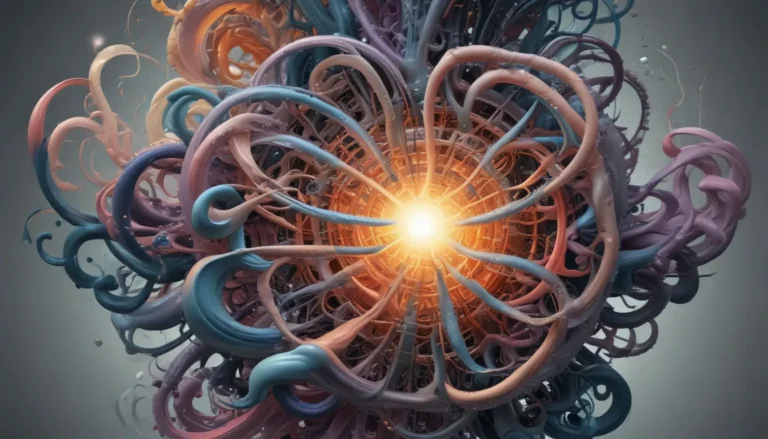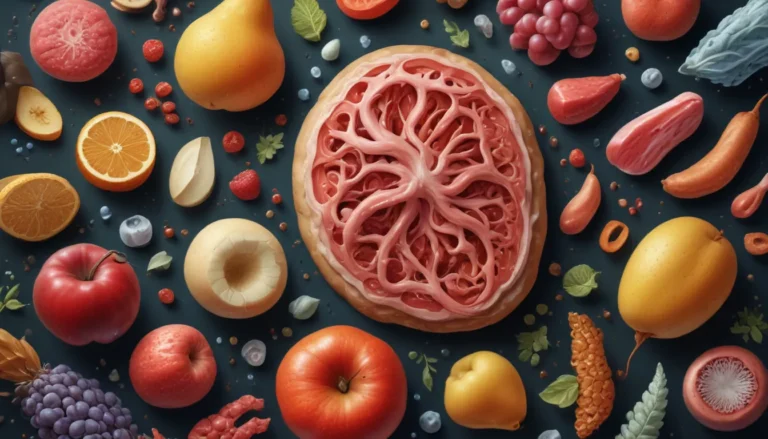A Note About Images: The images used in our articles are for illustration purposes only and may not exactly match the content. They are meant to engage readers, but the text should be relied upon for accurate information.
Deliquescence is a captivating natural phenomenon that occurs when certain substances absorb moisture from the air and dissolve, forming a liquid solution. While you may not have heard of this term before, deliquescence is a common occurrence in our daily lives, impacting everything from salt shakers to industrial processes. In this article, we will delve deep into the world of deliquescence, uncovering surprising facts and shedding light on its applications in various industries. So, let’s embark on a journey of discovery and unravel the mysteries of this intriguing process together.
The Enigmatic World of Deliquescence
Deliquescence is a unique process that allows certain substances to absorb moisture from the atmosphere and dissolve in it, resulting in the formation of a liquid solution. This phenomenon occurs when the vapor pressure of the substance surpasses the partial pressure of water vapor in the air. It’s like watching magic unfold as solids transform into liquids right before your eyes.
Unveiling Common Salts’ Deliquescence
Many common salts exhibit deliquescence, including compounds like calcium chloride, magnesium sulfate, and potassium carbonate. These substances readily absorb moisture from the air, becoming hydrated in the process. Next time you see salt clumping together on a humid day, remember that you are witnessing deliquescence in action.
The Role of Relative Humidity in Deliquescence
The ability of a substance to undergo deliquescence is influenced by the relative humidity of the surrounding environment. Higher humidity levels increase the likelihood of deliquescence occurring, leading to the dissolution of the substance in question. It’s a delicate dance between the solid and liquid states, driven by atmospheric conditions.
Practical Applications of Deliquescence
The deliquescence property of certain substances is not just a scientific curiosity; it has practical applications in various industries. For instance, calcium chloride is commonly used as a desiccant to remove moisture from the air, showcasing how deliquescence can be harnessed for beneficial purposes. It’s like harnessing the power of nature to solve everyday challenges.
The Formation of Concentrated Solutions
When a deliquescent substance absorbs moisture from the air and dissolves, it can lead to the creation of highly concentrated solutions. These solutions play a vital role in chemical reactions and manufacturing processes, highlighting the significance of deliquescence in various industrial applications. It’s a subtle yet powerful transformation that opens up a world of possibilities.
The Reversibility of Deliquescence
Interestingly, some deliquescent substances can reverse the process if humidity levels decrease. This reversibility makes these substances ideal for applications where moisture control is crucial, offering a degree of flexibility in their usage. It’s like having a safety net in place to manage unexpected changes in atmospheric conditions.
The Corrosive Impact of Deliquescent Substances
Certain deliquescent substances, especially salts, have the potential to promote corrosion when they come into contact with metals. The absorbed moisture and dissolved salts create an electrolytic environment that accelerates the corrosion process, emphasizing the need for caution when managing these substances. It’s a reminder that even seemingly harmless processes can have unintended consequences.
Deliquescence in the Pharmaceutical Industry
In the pharmaceutical industry, controlling the moisture content of drugs is paramount to ensuring their stability and efficacy. Deliquescence can influence the properties of pharmaceutical products, underscoring the importance of proper storage and packaging practices. It’s a delicate balance between moisture control and product integrity that pharmaceutical companies must navigate.
Atmospheric Chemistry and Deliquescence
The deliquescence behavior of certain salts can have far-reaching implications for atmospheric chemistry. Aerosol particles containing deliquescent salts can react with other gases and particles in the atmosphere, leading to the formation of secondary aerosols. This interplay between substances shapes the composition of our atmosphere, showcasing the interconnectedness of natural phenomena.
Safeguarding Sensitive Materials from Deliquescence
Materials that are sensitive to moisture, such as chemicals, electronics, and documents, require meticulous care to prevent deliquescence and subsequent degradation. These materials must be stored in environments with controlled humidity levels to avoid adverse effects, highlighting the importance of proactive measures in preserving sensitive items. It’s a testament to the delicate balance required to protect valuable assets from environmental influences.
Witnessing Deliquescence in Everyday Life
Have you ever marveled at how salt clumps together on a humid day? That’s a prime example of deliquescence in action, where the salt absorbs moisture from the air, dissolves, and forms clumps. It’s a familiar yet remarkable sight that underscores the prevalence of scientific phenomena in our daily experiences.
The Influence of Temperature on Deliquescence
Temperature plays a crucial role in the deliquescence process. Higher temperatures can enhance the rate at which a substance absorbs moisture, while lower temperatures may inhibit or slow down the process. This temperature sensitivity adds another layer of complexity to the delicate balance of factors governing deliquescence. It’s a reminder that nature’s processes are intricately intertwined with environmental conditions.
Medicinal Uses of Deliquescent Substances
Some deliquescent compounds, such as ammonium chloride, have found applications in traditional medicine for their expectorant and antitussive properties. These substances aid in relieving coughs and facilitating the removal of excess mucus from the respiratory system. It’s a testament to the diverse roles that natural phenomena can play in promoting health and well-being.
Navigating Hazards Associated with Deliquescence
In environments with high humidity or during mishandling of deliquescent substances, there is a risk of spills, leaks, or the release of hazardous gases. Implementing adequate safety measures and storage practices is essential to mitigate these risks and ensure the safe handling of these substances. It’s a reminder of the importance of diligence and precaution in managing potentially hazardous materials.
The Influence of Crystal Structure on Deliquescence
The crystal structure of a deliquescent substance can significantly impact its ability to absorb moisture. Substances with porous or highly soluble crystal lattices are more prone to deliquescence compared to those with tightly packed structures. This structural diversity contributes to the variability in deliquescence behaviors observed across different substances. It’s a testament to the intricate relationship between molecular structure and physical properties.
Regulating Deliquescence with Hygroscopic Materials
Hygroscopic materials, such as silica gel or molecular sieves, offer a practical solution for controlling humidity levels and preventing deliquescence. These materials effectively absorb moisture from the surrounding environment, reducing relative humidity and safeguarding sensitive substances from degradation. It’s like having a protective shield against the unpredictable nature of atmospheric moisture.
A Journey of Discovery: Unraveling the Essence of Deliquescence
Deliquescence is a captivating natural process that unveils the transformative power of moisture absorption in certain substances. From its prevalence in everyday life to its critical role in industrial processes and atmospheric chemistry, deliquescence touches various aspects of our world. By understanding the intricacies of deliquescence, we gain valuable insights into how substances interact with their environment and how we can harness these phenomena for practical applications.
FAQs: Exploring Common Queries About Deliquescence
Q: What causes deliquescence?
A: Deliquescence is initiated by the absorption of moisture from the air by a solid substance, leading to its dissolution into a liquid solution.
Q: How does relative humidity impact deliquescence?
A: Deliquescence transpires at a threshold known as the deliquescence relative humidity (DRH), where a substance can absorb sufficient moisture to transition into a liquid state.
Q: Which substances are prone to deliquescence?
A: Various substances, including salts like sodium chloride and calcium chloride, as well as organic compounds like sugars and certain acids, exhibit deliquescence.
Q: Are there practical applications of deliquescence?
A: Yes, deliquescence finds utility in drying agents, chemical reactions, and environmental monitoring, demonstrating its relevance in diverse fields.
Q: Can deliquescence be reversed?
A: Deliquescence can be reversed by eliminating moisture or lowering humidity levels, a process commonly referred to as efflorescence.
Q: How does deliquescence affect substance stability?
A: Deliquescence can significantly alter the stability of substances by modulating their properties, such as melting point, boiling point, and reactivity.
In Conclusion: Embracing the Intriguing World of Deliquescence
Deliquescence stands as a testament to the dynamic interplay between solids and liquids in our natural environment. By unraveling the intricacies of this fascinating process, we gain a deeper appreciation for the transformative power of moisture absorption in substances. From its practical applications in various industries to its impact on atmospheric chemistry and pharmaceutical stability, deliquescence offers a wealth of insights waiting to be explored. So, join us on this journey of discovery and immerse yourself in the captivating realm of deliquescence.






